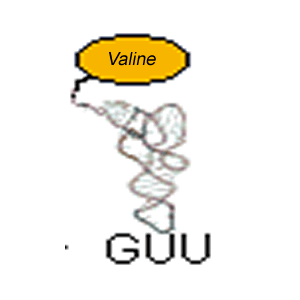The process of translation starts with the Messenger RNA (mRNA). Messenger RNA is a copy of the genetic code as determined by the sequence of bases on the DNA molecule. The process by which DNA is copied into mRNA is known as transcritpion.
After copying the short segment of DNA, commonly reffered to as a gene, the mRNA promptly moves out of the nucleus where its code is translated by ribosomes.
A few things to note in the process of translation:
-the translation starts with the coding for the amino acid methionine (not shown in the animation below). Click to see an animation of the process of translation. Source unknown.
-the bases on the mRNA are translated three at a time. Each three base sequence is known as a codon and codes for a specific amino acid. It takes many codons to produce a protein.;
-the amino acids needed to form the protein are present in the cytosol attached to tRNA;
-the tRNA is a coiled strand of RNA with an anticodon at one end. An anticodon is a set of three bases complementray to three bases forming a codon on the mRNA;
-each tRNA carries a specific amino acid;
-the codon on the mRNA and the anticodon on the tRNA attract each other and momentarily bond via hydrogen bonding. This allows the aminoacids to come close to each other and form a strong, covalent bond known as a peptide bond;
-translation terminates when a stop codon is reached. The animation below shows a stop codon (UAA). The stop codon attracts a protein called a release factor. This release factor occupies the site of the stop codon which initiates the break up of the ribosome subunits.
Click to see a simplified version of the process of translation.

A DNA sequence codes for three amino acids. The sequence of bases is given below
AGA ATG GTA
What are the three anticodons on the respective tRNAs?
Below is a question from VCAA.
Sickle cell haemoglobin: threonine – proline – valine – glutamic acid – lysine
The codons for these amino acids are shown on the right.
| Amino acid | Codons |
| threonine | ACU,ACC,ACA,ACG |
| proline | CCU,CCC,CCA,CCG |
| glutamic acid | GAU,GAC,GAA,GAG |
| valine | GUU,GUC,GUA,GUG |
| lysine | AAA,AAG |
A. the sickle cell mutation could have arisen from the eighth base in the DNA sequence of the segment being altered from adenine to uracil;
B. the anti-codons involved in translation of the sickle cell haemoglobin could be, in order
UGA – GGG – CAG – CUC – UUC;
C. the altered sequence could have arisen during transcription, when the amino acid valine was brought into the growing peptide chain instead of the amino acid glutamic acid;
D. the DNA sequence of the normal haemoglobin could be, in order
TGA – GGG – CAG – CTT – TTT;
The following strand of mRNA is composed of five codons A C U C C U G A U C C U A A A
1) Write the amino acid sequence coded for by this section of mRNA
2) Write the base sequence of the template DNA strand responsible for the above mRNA strand.
-DNA are called a
-mRNA are called a
-tRNA are called a
The codon GAU codes for glutamic acid.
It is reasonable to suggest that
